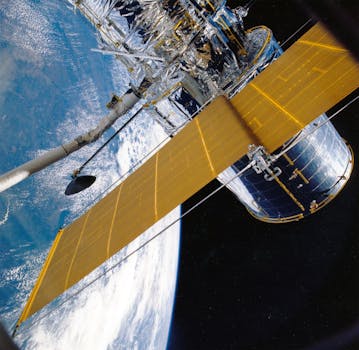
Beyond Earth: How Recent Advances Are Shaping Satellite Telecommunications
Satellite telecommunications has undergone significant transformations in recent years, with advancements in technology and infrastructure paving the way for a new era of communication beyond Earth’s boundaries. Beyond Earth: How Recent Advances Are Shaping Satellite Telecommunications is an exciting topic that has garnered significant attention in the industry. The focus keyword Satellite Telecommunications is at the forefront of this revolution, with companies and organizations investing heavily in research and development to improve the quality and accessibility of satellite-based communication services.
One of the key drivers of this growth is the increasing demand for global connectivity. As the world becomes more interconnected, the need for reliable and high-speed communication services has never been more pressing. Satellite telecommunications has risen to the challenge, with the launch of new satellite constellations and the development of advanced technologies such as beam-hopping and satellite-based 5G networks. These advancements have enabled faster data transfer rates, lower latency, and greater coverage, making satellite telecommunications a vital component of modern communication systems.
The use of satellite telecommunications is not limited to voice and data services. It also plays a critical role in navigation, remote sensing, and weather forecasting. The Global Positioning System (GPS), for example, relies on a network of satellites orbiting the Earth to provide location information and timing signals. Similarly, satellite-based remote sensing technologies are used to monitor environmental changes, track natural disasters, and predict weather patterns. These applications have far-reaching implications for various industries, including agriculture, transportation, and emergency response.
Recent Advances in Satellite Telecommunications
Recent years have seen significant advancements in satellite telecommunications, driven by improvements in technology and infrastructure. Some of the key developments include the launch of new satellite constellations, such as OneWeb and Starlink, which aim to provide global coverage and high-speed internet services. These constellations are designed to offer faster data transfer rates, lower latency, and greater coverage, making them ideal for applications such as online gaming, video streaming, and cloud computing.
Another area of advancement is the development of advanced satellite technologies, such as beam-hopping and satellite-based 5G networks. Beam-hopping is a technique that allows satellites to switch between different beams, enabling them to provide coverage to multiple regions and increasing their overall capacity. Satellite-based 5G networks, on the other hand, are designed to provide high-speed and low-latency communication services, making them suitable for applications such as smart cities, autonomous vehicles, and industrial automation.
The use of artificial intelligence (AI) and machine learning (ML) is also becoming increasingly prevalent in satellite telecommunications. AI and ML algorithms can be used to optimize satellite operations, predict maintenance needs, and improve the overall efficiency of satellite-based communication systems. These technologies can also be used to analyze data from satellite-based sensors, enabling the detection of patterns and anomalies that may not be apparent through human analysis alone.
Impact of Recent Advances on the Industry
The recent advances in satellite telecommunications are having a profound impact on the industry, enabling new applications and business models that were previously not possible. One of the key benefits is the ability to provide global coverage, enabling communication services to be offered in remote and underserved areas. This has significant implications for industries such as finance, healthcare, and education, where access to reliable communication services is critical.
The growth of satellite telecommunications is also driving innovation in related industries, such as spacecraft manufacturing and launch services. The development of new satellite constellations and advanced technologies is creating new opportunities for companies that specialize in these areas, driving investment and job creation. Additionally, the increasing use of satellite-based communication services is driving demand for related products and services, such as satellite dishes, modems, and network equipment.
Conclusion
In conclusion, recent advances in satellite telecommunications are transforming the way we communicate beyond Earth’s boundaries. The development of new satellite constellations, advanced technologies, and the use of AI and ML are driving growth and innovation in the industry, enabling new applications and business models that were previously not possible. As the demand for global connectivity continues to grow, satellite telecommunications will play an increasingly important role in meeting this demand, providing reliable and high-speed communication services to people and organizations around the world.



